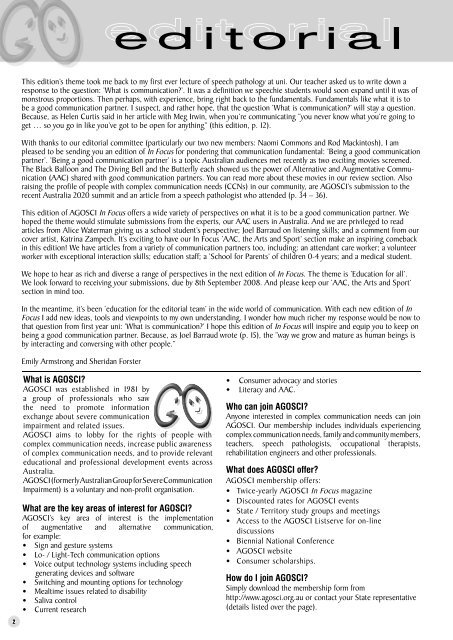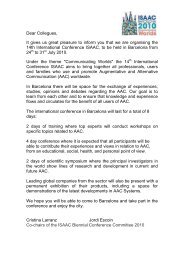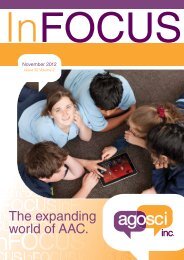May 2008 Edition - agosci
May 2008 Edition - agosci
May 2008 Edition - agosci
Create successful ePaper yourself
Turn your PDF publications into a flip-book with our unique Google optimized e-Paper software.
editorialThis edition’s theme took me back to my first ever lecture of speech pathology at uni. Our teacher asked us to write down aresponse to the question: ‘What is communication?’. It was a definition we speechie students would soon expand until it was ofmonstrous proportions. Then perhaps, with experience, bring right back to the fundamentals. Fundamentals like what it is tobe a good communication partner. I suspect, and rather hope, that the question ‘What is communication?’ will stay a question.Because, as Helen Curtis said in her article with Meg Irwin, when you’re communicating “you never know what you’re going toget … so you go in like you’ve got to be open for anything” (this edition, p. 12).With thanks to our editorial committee (particularly our two new members: Naomi Commons and Rod Mackintosh), I ampleased to be sending you an edition of In Focus for pondering that communication fundamental: ‘Being a good communicationpartner’. ‘Being a good communication partner’ is a topic Australian audiences met recently as two exciting movies screened.The Black Balloon and The Diving Bell and the Butterfl y each showed us the power of Alternative and Augmentative Communication(AAC) shared with good communication partners. You can read more about these movies in our review section. Alsoraising the profi le of people with complex communication needs (CCNs) in our community, are AGOSCI’s submission to therecent Australia 2020 summit and an article from a speech pathologist who attended (p. 34 – 36).This edition of AGOSCI In Focus offers a wide variety of perspectives on what it is to be a good communication partner. Wehoped the theme would stimulate submissions from the experts, our AAC users in Australia. And we are privileged to readarticles from Alice Waterman giving us a school student’s perspective; Joel Barraud on listening skills; and a comment from ourcover artist, Katrina Zampech. It’s exciting to have our In Focus ‘AAC, the Arts and Sport’ section make an inspiring comebackin this edition! We have articles from a variety of communication partners too, including: an attendant care worker; a volunteerworker with exceptional interaction skills; education staff; a ‘School for Parents’ of children 0-4 years; and a medical student.We hope to hear as rich and diverse a range of perspectives in the next edition of In Focus. The theme is ‘Education for all’.We look forward to receiving your submissions, due by 8th September <strong>2008</strong>. And please keep our ‘AAC, the Arts and Sport’section in mind too.In the meantime, it’s been ‘education for the editorial team’ in the wide world of communication. With each new edition of InFocus I add new ideas, tools and viewpoints to my own understanding. I wonder how much richer my response would be now tothat question from first year uni: ‘What is communication?’ I hope this edition of In Focus will inspire and equip you to keep onbeing a good communication partner. Because, as Joel Barraud wrote (p. 15), the “way we grow and mature as human beings isby interacting and conversing with other people.”Emily Armstrong and Sheridan Forster2What is AGOSCI?AGOSCI was established in 1981 bya group of professionals who sawthe need to promote informationexchange about severe communicationimpairment and related issues.AGOSCI aims to lobby for the rights of people withcomplex communication needs, increase public awarenessof complex communication needs, and to provide relevanteducational and professional development events acrossAustralia.AGOSCI (formerly Australian Group for Severe CommunicationImpairment) is a voluntary and non-profi t organisation.What are the key areas of interest for AGOSCI?AGOSCI’s key area of interest is the implementationof augmentative and alternative communication,for example:• Sign and gesture systems• Lo- / Light-Tech communication options• Voice output technology systems including speechgenerating devices and software• Switching and mounting options for technology• Mealtime issues related to disability• Saliva control• Current research• Consumer advocacy and stories• Literacy and AAC.Who can join AGOSCI?Anyone interested in complex communication needs can joinAGOSCI. Our membership includes individuals experiencingcomplex communication needs, family and community members,teachers, speech pathologists, occupational therapists,rehabilitation engineers and other professionals.What does AGOSCI offer?AGOSCI membership offers:• Twice-yearly AGOSCI In Focus magazine• Discounted rates for AGOSCI events• State / Territory study groups and meetings• Access to the AGOSCI Listserve for on-linediscussions• Biennial National Conference• AGOSCI website• Consumer scholarships.How do I join AGOSCI?Simply download the membership form fromhttp://www.<strong>agosci</strong>.org.au or contact your State representative(details listed over the page).





